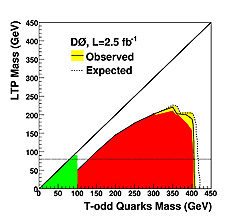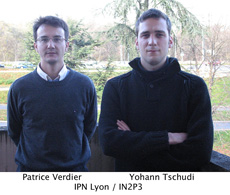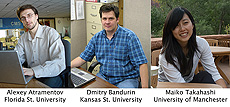|
Thursday, Nov. 20
THERE WILL BE NO PHYSICS AND DETECTOR SEMINAR THIS WEEK
9 a.m. - 7 p.m.
CMS Upgrade Workshop
- One West
2:30 p.m.
Theoretical Physics Seminar - Curia II
Speaker: Elvira Gamiz, University of Illinois, Urbana-Champaign
Title: Lattice Determination of B0bar-B0 Mixing Parameters in the Standard Model and Beyond
3:30 p.m.
DIRECTOR'S COFFEE BREAK - 2nd Flr X-Over
THERE WILL BE NO ACCELERATOR PHYSICS AND TECHNOLOGY SEMINAR TODAY
Friday, Nov. 21
8:30 a.m. - 5:30 p.m.
Project X Collaboration Meeting
3:30 p.m.
DIRECTOR'S COFFEE BREAK - 2nd Flr X-Over
4 p.m.
Joint Experimental-Theoretical Physics Seminar - One West
Speaker: Katsuki Hiraide, Kyoto University
Title: Search for Charged Current Coherent Pion Production by Neutrinos at SciBooNE
8 p.m.
Fermilab International Film Society - Ramsey Auditorium
Title: Cinema Paradiso
Tickets: $5 for adults
Saturday, Nov. 22
8 p.m.
Fermilab Arts Series - Ramsey Auditorium
Klezmatics: Grammy Award Winning World Music
Tickets: $25/$13
Click here for NALCAL,
a weekly calendar with links to additional information. |
|
Thursday, Nov. 20
- Tomato Florentine
- *Pork BBQ sandwich
- Pasta primavera
- Smart cuisine: chicken marsala
- Smoked turkey melt
- Assorted sliced pizza
- SW chicken salad w/roasted corn salsa
*Carb restricted alternative
Wilson Hall Cafe menu |
|
Thursday, Nov. 20
Dinner
- Steamed mussels with white wine & thyme
- Grilled marinated lamb chops
- Mushroom risotto
- Sautéed spinach
- Mocha soufflé
Wednesdsay, Nov. 26
Lunch
- Cheese fondue
- Marinated vegetable salad
- Mixed berry parfait
Chez Leon menu
Call x3524 to make your reservation. |
|
|
Universities, Fermilab both benefit from collaboration

View a map and list of the universities that collaborate with Fermilab. Click on the graphic above to download the pdf.
University collaboration is the norm in high-energy physics experiments. But for students interested in accelerator physics, working with a national laboratory is often essential.
Professors and students from more than 104 U.S. institutions in 34 states rely on Fermilab for their research, and the laboratories benefit from their participation as well.
Before the 1970s, universities could build their own high-energy particle accelerators, said Ashutosh Kotwal, a professor of physics at Duke University. "But eventually they became too big for any university group to build and fund locally." Since that time, accelerator expertise at universities has declined, and only a handful of universities still maintain accelerator physics programs.
But some high-energy physics faculty, such as Sacha Kopp of the University of Texas at Austin, have formed relationships with Fermilab to allow their students to work on projects related to accelerators.
National laboratories can offer students a course of study focused intensely on the subject they want to pursue, said Bob Zwaska, a Fermilab employee and former student of Kopp. "University programs may not have special classes in accelerator physics," Zwaska said. "This is a stimulating place to be." As a student, Zwaska worked at Fermilab on a system that synchronizes the beam in the Booster accelerator with the beam already circulating in the Main Injector.
Universities offer laboratories additional manpower as well as contact with experts from different fields, such as engineering and computer science. Kotwal became involved with particle physics when one of his engineering professors helped design electronics for a detector at Fermilab.
For students, working at a laboratory means joining a collaboration instead of simply turning work in to a professor, Zwaska said. "It's more collegial than at universities, where there's a larger difference between professors and students," he said. "At the lab, everyone works together."
-- Kathryn Grim
|
Fermilab earns award for marsh restoration project

Fermilab Roads and Grounds employee Dave Shemanske (center) accepted a natural landscaping award from the Chicago Wilderness Council and the U.S. EPA Nov. 12 on the laboratory's behalf. Shemanske stands with Gary Gulezian, director of the U.S. EPA Great Lakes National Program Office (left) and John Rogner, the chair of Chicago Wilderness. The award was given for the conversion of a former sewage treatment area into a natural marsh. Read more about the Nepese Marsh restoration in the Nov. 12 issue of Fermilab Today.
|
The Klezmatics perform at Fermilab Saturday, 8 p.m.

The Klezmatics
World-renowned and Grammy-winning band The Klezmatics will bring their unique brand of klezmer music to Ramsey Auditorium on Saturday, Nov. 22, at 8 p.m. Klezmer, from the Yiddish word for "musician," has its roots in the celebratory music that Ashkenazi Jews traditionally played at weddings and other occasions for dancing.
The Klezmatics erupted out of New York City's East Village in 1986. Over the course of 20 years, the group has released nine albums of provocative, reflective and ecstatically danceable music played with fiddle, bass, cello, clarinet, drum, hammer dulcimer and accordion. A multitude of mainstream media outlets such as the BBC, PBS, MTV and NPR have featured the band on their programming.
Tickets are $25 for adults and $13 for children aged 18 and under. For more information or to make reservations, call (730) 840-ARTS (2787) weekdays from 9 a.m. to 4 p.m. At other times, an answering machine will give you information and a means of placing ticket orders. Ramsey Auditorium is located in Wilson Hall, the central building at Fermilab.
|
Antarctic balloon on the trail of dark matter?
From Scientific American, Nov. 19, 2008
New results from an instrument that detects energetic particles in the upper altitudes above Antarctica show an excess of cosmic-ray electrons that may be a signal of dark matter, researchers say. The study, published today by Nature, examines data from a balloon-borne detector called ATIC (Advanced Thin Ionization Calorimeter). The unexpected wealth of electrons in a specific energy range, about 300 to 800 giga-electron-volts, points to a nearby source, the authors write.
One of the possible sources is the annihilation of dark matter, a mysterious type of particle that current theories indicate is many times more prevalent in the universe than the ordinary matter we can see and touch. Some candidates for dark matter, including the so-called Kaluza-Klein particles, would have energies that fit the bill. (The authors speculate that other astronomical objects, such as pulsars or microquasars, could also be responsible.)
Read more
|
|
|
DZero's new phenomena dragnet

This figure shows the masses of T-odd quarks and the lightest T-odd particle (LTP) that are excluded by DZero's data analysis.
In the mad morning rush to get to work or school, there's nothing worse than discovering you've lost your keys. After racking your brain, you realize those keys could be anywhere. Once you've narrowed down the possible hiding places (they're not in the freezer!), the only thing left is to begin a search.
Every day physicists at the Tevatron dive headlong into the farthest depths of the unknown in an effort to find signs of new physics. Theoretical physicists help narrow down the hiding places by constructing theories that are consistent with experimental evidence. Often these searches come up empty, but these results are valuable because they tell physicists where the particles, like keys, are not hiding. Physicists at the DZero experiment have found a way to speed this process up. Surely to the envy of distraught key seekers worldwide, these physicists have shown that they can search in two places at the same time.
A simultaneous probe for two different new phenomena scenarios increases the chances for DZero physicists to find the key to new physics. Many models for new phenomena predict heavy, stable, electrically neutral particles that interact very little with ordinary matter. If produced at the Tevatron, these particles would pass through detectors unnoticed, just like the well-known neutrino. Such particles can arise in theories known as Little Higgs models. Little Higgs models with T parody predict heavy cousins of quarks (T-odd quarks) that could decay to a heavy, stable cousin of the photon and a normal quark.
This signature could also be produced by the decay of leptoquarks, which are particles that provide a link within the three generations of quarks and leptons and have both quark and lepton properties. Dzero has constructed a search that accommodates these two similar signatures.
Using 2.5 inverse femtobarns of data, DZero researchers studied events with the particle-jet signature characteristic of quarks along with the missing energy signature of neutrinos. In events with two jets that are not back-to-back and have large amounts of missing transverse energy, the physicists found no evidence for new phenomena. These results allow them to produce the world's tightest limits on the masses of T-odd quarks and also to improve on existing limits for scalar leptoquarks coupling to neutrinos and quarks within the first and second generations. This efficient search technique will be an important strategy as DZero researchers study their ever-growing dataset, hopefully uncovering those keys that will unlock our knowledge of the universe.
Read more

A team of DZero collaborators made primary contributions to this analysis.

DZero's electromagnetic objects identification group is responsible for developing and maintaining algorithms to select electrons and photons in data and simulation. After years as co-convener of the group, Alexey Atramentov (left) has handed the torch to Maiko Takahashi (right) who will join Dmitry Bandurin (center).
|
|